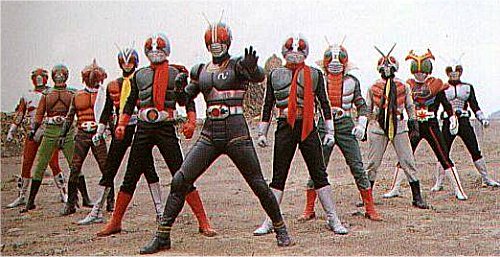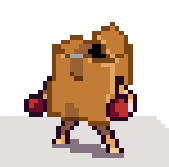The Game In Question.
Let's examine this with Chroma Squad as a specific example, shall we? The combat, as it stands, does indeed start off fairly simple, without a whole ton of apparent depth. You have five guys who are part of a Sentai studio, Sentai being a term for a specific genre of superhero shows from Japan. They each get two actions a turn, while enemies generally get one unless they can also attack or use a special ability. Those two actions generally consist of a move, followed by one of the following:
- Move some more.
- Hit someone.
- Use a special ability (which often involves hitting someone, but with a weapon.) We'll discuss this more in a bit.
- TEAMWORK.
Near the end of a fight from the original Demo.
So, by my count, we have basic mechanics, plus a mechanic that can then change other mechanics. But wait, there's more! See, because Sentai episodes often start with the heroes in their everyday garb, instead of being ULTRA-TEAM or whatever, our characters start that way too, nearly every "Episode". And once they hit a certain number of Fans, they can CHROMATISE (or whatever you've chosen to call it.) What does that do?
First off, it relocates all party members to a certain position (don't ask me how it's worked out, I haven't fully checked, and it's probably subject to change), and it fully heals the party as they're given a second wind by their magical powers. It also boosts their damage on hitting folks, and allows them to use their Special Abilities.
I think we've hit another level of tactical choice here. Because when you Chromatise is an important tactical consideration. On the one hand, you can thin out mooks just fine by using Teamwork, and you can, if you're canny, even damage bosses that way. But you can only get that sweet, sweet full heal once per Episode, and, to make the choice harder, you can't use some of your best attacks (including the Finishing Move) until you've done it. Some Episodes, for extra challenge, don't let you Chromatise at all.
This is already sounding above the depth level for your average Western RPG focused on combat, where, yes, you have more options to start with (Do I use Magic Missile, or Paralyzing Ray, or [goes on for half a minute]...?), but they amount to, in essence, much the same things (Do I do ranged damage? Do I do melee damage? Do I play Rock-Paper-Scissors with Elemental damage?). It even cuts down on options in the game that are objectively less useful than their counterparts with other party members (DnD Psionics, I'm looking at you!)
Remember folks, more choices doesn't necessarily mean extra depth. It's terribly easy to confuse the two, as games have shown in the past. But we then come to a very important question: Even if it were shallow, would it be badly designed?
For the answer to that, let's look at what it's aiming for. Firstly, it's aiming for being fun, as games often do. This is a largely subjective thing, and so we're going to largely skip it. I personally find it fun. Secondly, it's aiming to simulate (to a limited extent) the genre of TV it's based on. So I'll sum up what characterises Sentai, and we'll judge based on that whether it succeeds.
Various incarnations of Kamen Rider. Budget for each costume? Probably around £150, if that.
Sentai Shows Are Often Low Budget
Anyone who's seen Power Rangers has seen one of the higher budget Sentai Shows produced. Especially when they got into movie territory. But most Sentai Shows are not like that. Take a look at Ultraman, or early Kamen Rider. They're low budget as hell. Hell, go look up the Sentai version of Spider-Man, a thing that exists, and both amuses and horrifies me as a Spidey fan.
In Chroma Squad, you start with a budget of $1000. Your first season is mostly filmed on the street, or in warehouses, your costumes are made of buckets, cloth, and hope, and, no joke, one of the studio "upgrades" you can buy is... an SD camera. SD, as in "Standard Definition for the modern day."
There's also a mechanic for recycling your old stuff to craft new stuff, with no guarantee you'll get anything useful out of your old costumes or weapons. And most of your "filler" episodes (which you're contractually obligated to record) won't make you more than around $50. At best.
Yeah, I think it nailed the feel of a low budget studio. And that's without going into the jokes on the subject, like Cardboard Boxer or the girl who doesn't get dialogue, because she wasn't paid for that. That's actually a really common thing in film extra work, as an aside: Talking roles pay more.
Sentai Shows Are Fuelled By Their Fandom
It sounds obvious, but when you factor in that Sentai Shows are often recorded on a stupidly low budget, every fan who might be able to pay you a favour counts, especially in the early days... Especially since those favours might be material for the show, such as access to filming venues. And, in Chroma Squad, your fans count in multiple ways. You can't Chromatise without pleasing fans. You can't earn diddly if you disappoint your fans, and there are emails you'll get from fans that may unlock better gear or certain episodes down the line.
Again, this nails it, as Sentai groups often do live performances, and, like wrestling, it's the Call to the audience that determines what happens.
Amazingly, I couldn't find some cool flips. But trust me, Sentai has them in SPADES.
Sentai Fights Are Flashy, And Often Formulaic
Game design wise, this one seems like a gimme: Strategic RPGs have fixed fights with scripted behaviour that you're meant to exploit to win. But let's look at the formula a little for a standard fight.
- Mooks ambush our heroes.
- Fight ensues, and there's a lot of flipping around, positioning, and double-teaming.
- The heroes discover that there's Too Many, and decide to POWER UP!
- Mooks (and even the Big Bad) stand back and let this happen (generally, there are exceptions)
- ASSKICKING TIME.
This formula is heavily encouraged in the first Episode, with Fan Requirements. These are essentially little challenges that get you more Fans (and thus more money, gear, and little things you need to craft shit), and, in this case, we have certain challenges for the three Acts of the first Episode (I've been capitalising these, by the way, because they're essentially different names for, in game-design parlance, Levels.)
First act, you have to do three "Team Acrobatics" (use Teamwork to move people further), and all be above 50% health by the end of the fight. So there's your flipping, and the impression that the Mooks are just... Well, Mooks.
The Big Bad of the Season reveals himself (and he is suitably silly), and the Second Act begins. Here, we have to beat four Mooks in one turn, and beat the last with a Finishing Move. Suitably dramatic, but it's important to note two things here: Firstly, the first requirement isn't possible without taking some form of beating, and secondly, the optimal strategy here is to go for one of the corners, lure four guys in, get them down to half health or less, smack 'em down, and the last guy gets lured into the Finisher.
This is often what happens in a Sentai fight.
Finally, we have the Third Act. Cardboard Boxer has entered the scene, surrounded by mooks. But if we want the full Fan Appeal, we have to beat CB with a Finisher, and we mustn't attack him until all the Mooks are gone. Again, it works with the theme, and proves challenging, because Cardboard Boxer isn't restrained by your petty heroic rules, and he hits like a bag of lead bricks.
Cardboard Boxer. In all his, er... Glory. Yes, Glory.
From the get go, it's there.
So now we come to the points (for lo, there are multiple) of this post: Firstly, choices do not equal depth, and just because you don't see the depth, doesn't mean it isn't there. More importantly, though, people conflate depth or choices with Good Game Design, and that just isn't true, because choices can balloon out of control and make the game messy, and layers of depth, as we've noticed, don't matter a jot if people don't notice.
No, it's far more important that you do what you set out to do, and keep it fun. Clickr isn't a game with the depth of Age of Wonders 3, but I enjoy both equally, because they're designed around their main themes and mechanics. So far, Chroma Squad is doing what it set out to do. It's by no means fully balanced yet, or easy enough for the newbie to get it on their first try (Speaking of: PUT YOUR TUTORIAL BACK IN, BEHOLD STUDIOS, REGARDS, A. GAMER), but, at least so far, it looks to be tightly designed around its theme, and that puts it in my Good Books for now.





No comments:
Post a Comment